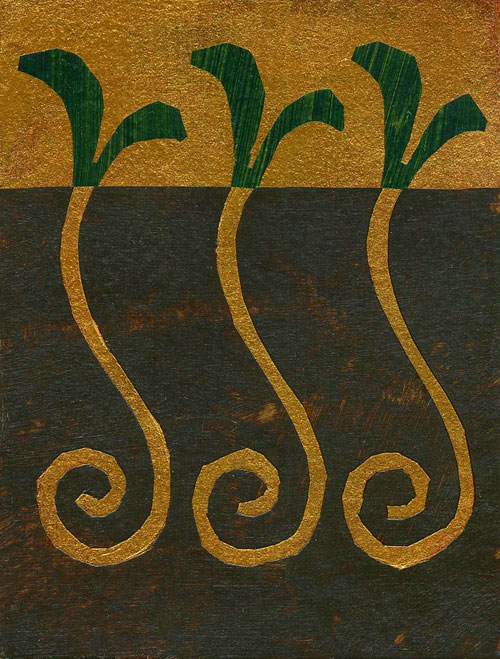
Getting Grounded © Jan L. Richardson
This week finds me packing my bags, getting ready to head to Minnesota for my always-anticipated annual retreat with fellow oblates of St. Brigid of Kildare Monastery. As usual, we’re having our gathering at a wonderful retreat house on the grounds of St. John’s Abbey, a Benedictine men’s community. Also as usual, our retreat falls over the Feast of St. Benedict (July 11), which always makes for a festive time to be hanging out with Benedictine folk. The retreat offers a near-embarrassment of Benedictine riches, in fact. In addition to having occasion to celebrate and pray with the monks and others connected with St. John’s, we’ll visit the sisters at St. Benedict’s Monastery just down the road, joining them for Vespers on the Eve of the Feast.
Throughout our retreat, we’ll also have our own rhythm of community prayer. Stepping together into the ancient rhythm of the Liturgy of the Hours, my fellow retreatants and I will keep a schedule that will include morning, noon, and evening prayer as well as compline, the nighttime prayer. Getting up for 7 AM morning prayer is a real stretch for this night owl. But entering that rhythm of prayer together for a few days, when we are otherwise a dispersed community praying in relative (if spiritually connected) solitude, is a cool thing.
Though we keep to a liturgy schedule that sets aside appointed times for prayer, the Liturgy of the Hours beckons us to a pace that is anything but task-oriented. It invites us to slow down and savor what the liturgy offers us: the Word that reveals itself in the scriptures, in the prayers, and in the silence. In her book The Cloister Walk (which she wrote during a stay at St. John’s), Kathleen Norris observes that liturgical time “is essentially poetic time, oriented toward process rather than productivity, willing to wait attentively in stillness rather than always pushing to ‘get the job done.'”
When not praying the Liturgy of the Hours, we’ll spend some of our retreat in sessions exploring this year’s theme, “Simplicity in the Monastic Tradition.” I’m delighted that one of the folks presenting a session this year will be Fr. Luke Dysinger, OSB. For years I’ve been passing around Fr. Luke’s online introduction to lectio divina, Accepting the Embrace of God: The Ancient Art of Lectio Divina, providing it as a resource on retreats and elsewhere. I particularly appreciate Fr. Luke’s discussion of what he calls lectio on life, which first got me thinking about our own lives as sacred texts—an idea that shapes much of my work these days.
With all this to look forward to, I’m intrigued that the lectionary offers us Matthew 13.1-9, 18-23 for this Sunday. The Parable of the Sower is all about the work to which both the Liturgy of the Hours and lectio divina invite us. These ancient practices each beckon us to be loiterers in the neighborhood of the Word, to hang out and dawdle with it, rather than moving through it with a briskness that assumes we know what it has to say. The liturgy and lectio both invite us to consider how we’re allowing God to cultivate us, how we are tending our interior earth as a place where the Word can take root and grow—not just for ourselves but for the life of the world.
As I head out tomorrow, I’ll be carrying those images that Jesus offers in this week’s gospel lection. I’m curious to see what earth might get moved in my soul in the coming days, what new ground God might challenge me to give. How about you? What sort of cultivation is going on in your soul these days? Is there any earth that God might be inviting you to offer? What practices are you keeping—or needing—that help you do this kind of sacred groundwork?
Me, I’m off to finish packing. Blessings to you in all your journeying.
[To use the “Getting Grounded” image, please visit this page at janrichardsonimages.com. Your use of janrichardsonimages.com helps make the ministry of The Painted Prayerbook possible. Thank you!]













July 8, 2008 at 6:01 PM |
Thanks for the link. I’m always hunting for brief explanations of lectio. Hope your time of grounding goes deep.
July 10, 2008 at 8:25 AM |
Dear Jan,
I am ever so inspired by your thoughts on these summer lessons. Thank you for the clarity you bring to the Word. Thank you for this blog.
Deepest blessings of the holy,
Anne R. from NH
July 10, 2008 at 7:28 PM |
A first read of this post had me scurrying to find my copy of ‘The Cloister Walk’ in order to re-visit some of its pages; later I spent quality time with FR Luke’s article re all of the lectios; today I noticed -could it have been for the first time? – the invitation that ‘beckons’ me ‘to loiter in the neighborhood of the Word…to dawdle….’, creating in me a new receptivity to God’s ‘be still….pause awhile…and know I AM’.
The Holy Whisperer encourages me to let the seeds already embedded in the earth that is me, be: there is internal dawdling to be done!
July 11, 2008 at 6:42 AM |
Jan….my prayer for you: Retreat, refresh and renew….and know that you are surrounded by the prayers of kindred spirits who know well the importance of dwelling in the presence of the one who nourishes you at the deepest core. Welcome home!